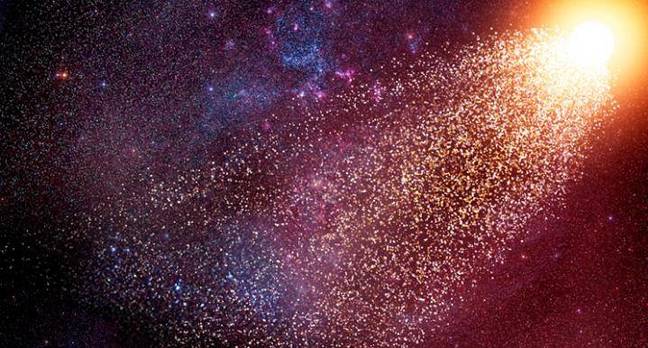Rare hypervelocity stars tearing through the Milky Way galaxy are runaway suns that have escaped neighboring galaxies, according to research presented at this year’s National Astronomy Meeting in Hull, England.
Hypervelocity stars are travelling between 300 and 700 kilometers (186 and 435 miles) per second faster than our galaxy’s escape velocity. Only 20 cases have been confirmed so far, most of them late B‑type stars that are larger than our sun. There has been some debate around the origin of these breakaway stars. Scientists believed a portion of them might have been lobbed from the Milky Way’s central rotational center.
But a paper published in the Monthly Notices of the Royal Astronomical Society in March makes the argument that all the hypervelocity stars are actually foreign objects. The research was presented at the National Astronomy Meeting in Hull on Wednesday.
The idea is that these ultra-fast stars were part of a binary system and escaped their original home – the Large Magellanic Cloud (LMC) – a neighbouring satellite galaxy. A supernova explosion made the orbit between both stars unstable, and the schism caused the smaller one to be booted far away like a ball in a slingshot.
A group of researchers from the University of Cambridge in the UK dug into data taken from the Sloan Digital Sky Survey to build computer simulations of runaway stars escaping from the LMC to the Milky Way. They started by modelling the stellar evolution of the birth and death of stars in the LMC over the past two billion years, and focused on every runaway star. The gravitational interactions between these stars were also simulated so that they could reproduce and track the trajectory of the stars. They predict that there are 10,000 runaway stars spread across the sky.
There should also be about a million runaway neutron stars or black holes, since some of the massive blue stars reach the end of their lives on their way out of the LMC. They should collapse to neutron stars or black holes that continue zipping through the Milky Way. Only half of the simulated stars that escape the LMC are fast enough to escape the gravity of the Milky Way, making them hypervelocity stars. If the confirmed hypervelocity stars are runaways, it would also explain their position in the sky.
'Hypervelocity stars did not satisfy me'
“Earlier explanations for the origin of hypervelocity stars did not satisfy me. The hypervelocity stars are mostly found in the Leo and Sextans constellations – we wondered why that is the case.” said Douglas Boubert, lead author of the paper and a PhD student at Cambridge’s Institute of Astronomy.
The closer stars in a binary system are, the faster they orbit one another, and they’re more likely to reach speeds fast enough to become hypervelocity stars. Runaway stars starting out in the Milky Way are too slow to become hypervelocity stars because the blue B‑type stars can’t orbit close enough to their companion star in the binary system without merging, the researchers argue.
But fast-moving galaxies like the LMC could give rise to these swift stars. The LMC also has 10 per cent of the mass of the Milky Way, so the fastest runaways can easily escape the galaxy’s pull. Like a bullet fired from a moving train, the speed of these escaping stars would be the velocity they were booted at plus the velocity of the LMC. This boost increases the likelihood that these stars become hypervelocity ones when they stream through the Milky Way.
“These stars have just jumped from an express train – no wonder they’re fast. This also explains their position in the sky, because the fastest runaways are ejected along the orbit of the LMC towards the constellations of Leo and Sextans.” said Rob Izzard, co‑author of the paper and a Rutherford fellow at the Institute of Astronomy.
“We’ll know soon enough whether we’re right The European Space Agency’s Gaia satellite will report data on billions of stars next year, and there should be a trail of hypervelocity stars across the sky between the Leo and Sextans constellations in the North and the LMC in the South.” said Boubert.
Another independent group of researchers are also hoping to study hypervelocity stars by trying to find more specimens through data withthe help of artificial neural networks.





No comments